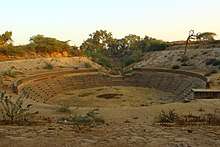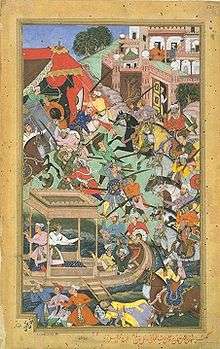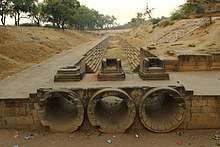Sahastralinga Tank
Sahasralinga Tank or Sahasralinga Talav is a medieval artificial water tank in Patan, Gujarat, India. It was commissioned during Chaulukya (Solanki) rule, but now it is empty and in a ruined state. It is a Monument of National Importance protected by Archaeological Survey of India (N-GJ-161).

Legend
Jasma Odan, a wife of Rooda who belonged to the Od community of tank diggers, cursed Chaulukya ruler, |Siddhraj Jaisinh]]who, captivated by her beauty, proposed marriage to her. Due to the curse, the tank would not fill with water. To repeal the curse, a human sacrifice was needed. Mayo or Mahya(Jay Vir Maghmaya), from the lower caste Vankar-(SC) community, sacrificed himself resulting in water filling the tank. Jaysinh, out of gratitude, allowed his caste to stay with higher castes in town.[1][2][3]
History

Sahasralinga Tank are among the many artificial tanks built in different parts of Gujarat under the patronages of Jayasimha Siddharaja (1092-1142 AD). Bairam Khan, Akbar's tutor, while passing through Patan on his way to Mecca, was said to have been murdered after he returned from boating in this tank in 1561.
Architecture
The architecture of this tank integrated the great sense of water management and sanctity of water in Hindu religion. The tank used to receive water from a canal of the Saraswati River and had spread of about 5 km with good stone masonry embankments. There were thousand Shiva Shrines on the edge of the tank. Some remains of the same are even visible today.
One of the largest and the grandest in size is the Sahasralinga Tank. It must have been a reservoir of immense size and derived its name from the numerous little temples containing linga placed on the banks which were dismantled during the late medieval period, when a large octagonal rouza was raised on a part of its ruins. The great embankment surrounding it is of solid brick work and was faced with stone masonry forming flights of steps to the water's edge. Near the middle of the eastern embankment are the remains of the old Siva temple, comprising the basements of the pavilions together with a colonnade of forty eight pillars; it was in good condition till 16th century A.D. Towards the western end there is a rudra kupa in which water from the river Saraswati was collected and then allowed to pass into the inlet channel of the Sahasralinga Tank. This cistern is about forty meters in diameter.[4]
Gallery
- Sahastralinga Tank Platform
 Water Inlets
Water Inlets Water inlets
Water inlets Platform
Platform Platform
Platform Canal of Water tank (Lake)
Canal of Water tank (Lake)- Channel
- Ruined pillars
 Ruined pillars
Ruined pillars
See also
Spelling confusion
Sahasra[5]is the correct suffix that means "a thousand", not SahasTra. However, it is invariably misspelled as the latter. Notice how the same suffix is spelled when it occurs in family names (example: Sahasrabuddhe[6]) without a T. The confusion arises because the hindi letter "Sa" (स) merges with "ra" (र) and looks like "tra".
References
- Bharati Ray (4 October 2005). Women of India: Colonial and Post-colonial Periods. SAGE Publications. pp. 527–. ISBN 978-0-7619-3409-7.
- Bharati Ray; Swati Joshi (2009). Different Types of History. Pearson Education India. pp. 374–. ISBN 978-81-317-1818-6.
- Gujarat (India) (1965). Gujarat State Gazetteers: Rajkot District. Directorate of Government Print., Stationery and Publications, Gujarat State. p. 138.
- Kaushik Pandya (2007). A journey to the glorious Gujarat. Akshara Prakashan. p. 103.
- "Sahasra".
- "Sahasrabuddhe".
| Wikimedia Commons has media related to Sahastralinga Talao. |